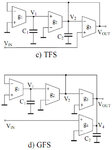lhlbluesky
Banned
i have designed a Gm-C BPF, biquad type with two OTA and two Cap. i set gm1=gm2=gm=13uS (low power design), C2=100*C1=1nF, f0=gm/sqrt(C1*C2)=20kHz, Q=sqrt(C2/C1)=10, now, the ac response shows that, f0 and Q has some deviation (20.4KHz and 9.23), what is the possible reason here?
besides, for a Gm-C BPF, how is the transient response? does the OTA need slew rate and settling (the same as OPA)? if so, for a 1nF cap, it is very difficult for the OTA to settle well. am i right?
thanks all.
besides, for a Gm-C BPF, how is the transient response? does the OTA need slew rate and settling (the same as OPA)? if so, for a 1nF cap, it is very difficult for the OTA to settle well. am i right?
thanks all.
